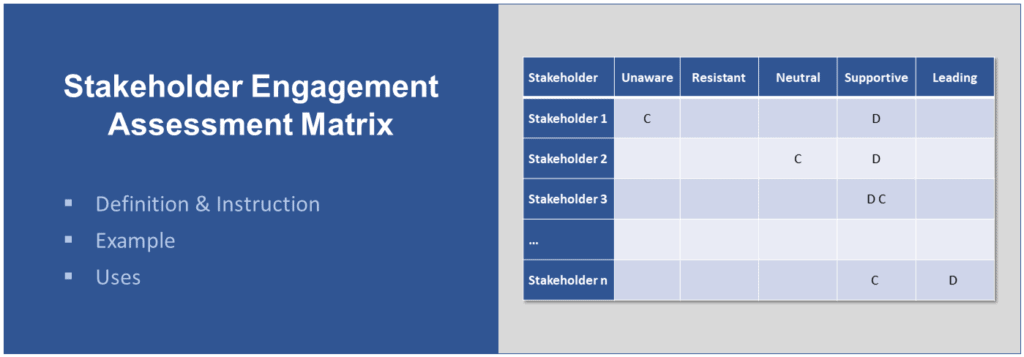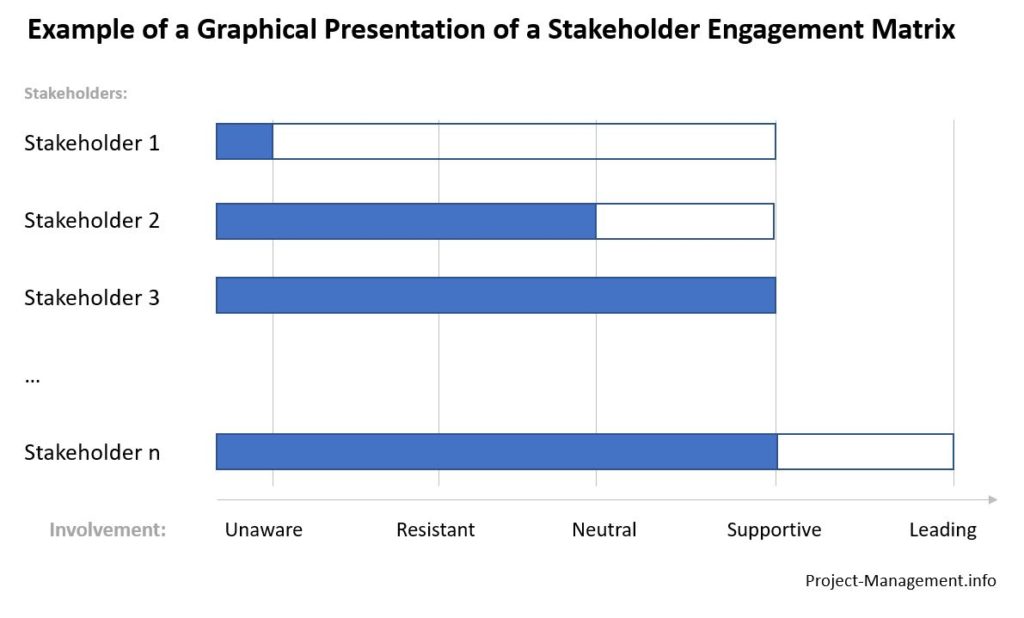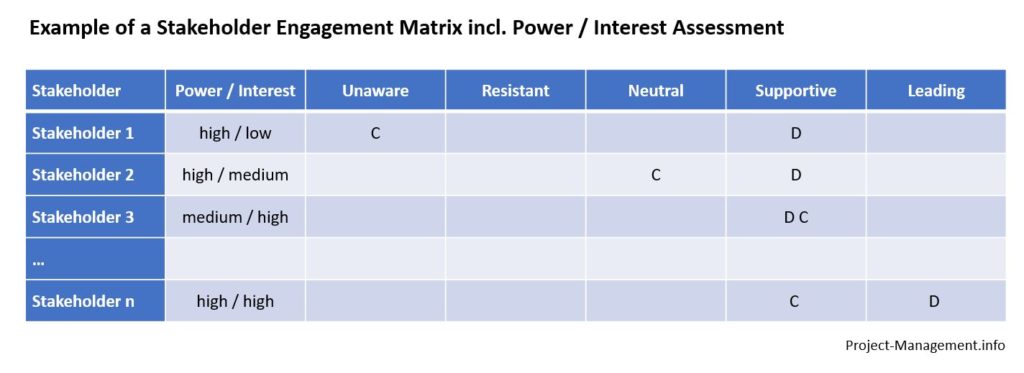Managing the involvement of stakeholders is one of the most challenging yet important tasks of a project manager. However, there tools and techniques such as the stakeholder engagement matrix that facilitate and improve a project’s stakeholder management significantly.
The Stakeholder Engagement Assessment Matrix is a simple yet powerful project management technique to document desired and monitor actual engagement levels of stakeholders. It helps identify potential gaps in the involvement of stakeholders.
Read on to learn more about the stakeholder engagement matrix and its uses in stakeholder engagement management.
What Is Stakeholder Engagement?
Every project has stakeholders. Yet the number and involvement of stakeholders vary greatly among the different types of projects and industries.
A small, lean software development project, for instance, might only have a few stakeholders. On the other hand, a mega-project, e.g. construction of infrastructure, can involve a huge number of individual stakeholders and groups of stakeholders.
Irrespective of the size of the project, managing a project’s relationship with stakeholders is crucial to ensure project success. This is especially true for influential and interested stakeholders.
How to Create a Stakeholder Engagement Matrix?
A stakeholder engagement assessment matrix consists of several rows, each of them representing one stakeholder (or a group of homogenous stakeholders, if applicable).
The columns indicate the level of engagement. The Project Management Body of Knowledge (PMBOK® Guide, 6 th ed., ch.13.2.2.5) suggests the following classification:
- unaware,
- resistant,
- neutral,
- supportive,
- leading.
Following the PMI’s taxonomy, the current level of engagement is documented with a “C”. The desired level is represented with a “D”.
A “C” can basically occur in any of these columns. However, a “D” is typically not applicable for the “unaware” or “resistant” columns for obvious reasons (do you really wish to have resistant stakeholders in your project?).
A populated stakeholder engagement assessment matrix looks like the following example (analogous fig. 13-6 in PMBOK®, 6th ed.):
| Stakeholder | Unaware | Resistant | Neutral | Supportive | Leading |
|---|---|---|---|---|---|
| Stakeholder 1 | C | D | |||
| Stakeholder 2 | C | D | |||
| Stakeholder 3 | D C | ||||
| … | |||||
| Stakeholder n |
Deviating from PMI’s proposed layout, some projects replace the matrix with a graphical way of presenting stakeholder engagement.
Some project managers prefer adding a column representing the interest and power of stakeholders (i.e. their importance for the project). This can be useful for evaluating the importance and priority of gaps identified.
How to Determine the Desired Stakeholder Engagement Level?
The Project Management Institute’s framework lists the
- needs,
- expectations,
- interests, and
- potential impact
of stakeholders as the criteria to determine their desired engagement level.
This assessment forms the basis of a project’s stakeholder engagement plan. The plan sets out the extent and way of the productive involvement of stakeholders in the project.
Note that the stakeholder engagement matrix is technically not a component of that plan but another output of the ‘plan stakeholder engagement’ process. However, the plan provides insights into the desired level of stakeholders’ involvement when compiling the stakeholder engagement matrix.
Other tools, techniques, and documents that can provide input for the stakeholder engagement matrix include but are not limited to:
- stakeholder analysis (identifying relevant stakeholders and their interests),
- stakeholder register (list and classification of stakeholders),
- power/interest grid and similar tools, and
- stakeholder cube or salience model.
What Is the Stakeholder Engagement Assessment Matrix Used for?
The stakeholder engagement matrix is a technique introduced in PMI’s Project Management Body of Knowledge as part of several processes.
These processes are:
- plan communications management (ch. 10.1),
- monitor communications (ch. 10.3),
- plan stakeholder engagement (ch. 13.2), and
- monitor stakeholder engagement (ch. 13.4).
Within the planning processes, a shareholder engagement matrix is used to document the desired degree of involvement of each relevant stakeholder.
In the monitoring processes, the shareholders’ actual engagement level is subsequently compared with the initially desired level of involvement. Thus, gaps (if any) can be identified and tackled by the project manager.
Example of a Stakeholder Engagement Assessment Matrix
In this example, we are looking at the stakeholders of a fictive Finance software transformation project.
The list of stakeholders consists of:
- Chief financial officer (sponsor),
- Chief executive officer,
- Chief information officer,
- Head of accounting,
- Head of regulatory reporting,
- Users of the new systems,
- IT architects,
- Internal Audit,
- External Auditors,
- etc.
When creating the stakeholder engagement assessment matrix, e.g. in the process ‘plan stakeholder engagement’, a project manager should refer to the stakeholder engagement plan for the desired level of engagement.
The desired level (“D”) of engagement is then incorporated into the stakeholder engagement matrix:
| Stakeholder | Unaware | Resistant | Neutral | Supportive | Leading |
| Chief financial officer (sponsor) | D | ||||
| Chief executive officer | D | ||||
| Chief information officer | D | ||||
| Head of accounting | D | ||||
| Head of regulatory reporting | D | ||||
| Users of the new system | D | ||||
| IT architects | D | ||||
| Internal Audit | D | ||||
| External Auditors | D | ||||
| … |
When monitoring the actual stakeholder engagement, the project manager adds the observed current level (“C”) of engagement for each stakeholder:
| Stakeholder | Unaware | Resistant | Neutral | Supportive | Leading |
| Chief financial officer (sponsor) | C D | ||||
| Chief executive officer | C | D | |||
| Chief information officer | C D | ||||
| Head of accounting | C D | ||||
| Head of regulatory reporting | C | D | |||
| Users of the new system | C | D | |||
| IT architects | C | D | |||
| Internal Audit | C D | ||||
| External Auditors | C | D | |||
| … |
As discussed before, the stakeholder engagement assessment matrix helps identify gaps between desired and actual engagement levels of stakeholders.
Looking at the matrix in this example, it becomes obvious that such a gap exists among certain stakeholders of this project:
The CEO could be more supportive. The same holds for the head of regulatory reporting and the organization’s IT architects. External auditors have not been involved yet despite deemed necessary in the stakeholder engagement plan.
Lastly, users of the new system developed resistance against the transformation while their support would be needed to ensure a smooth deployment and use of the new system.
These gaps are the areas where a project manager should improve his/her stakeholder engagement management going forward.
Obstacles and Challenges of Stakeholder Engagement Management
In the context of stakeholder engagement management, several obstacles and challenges can occur in practice.
One of the most relevant issues (from my perspective) is that project documents can easily be accessed by team members and stakeholders (source: PMP Study Guide by K. Heldman).
In other words, if you document the stakeholder classification and engagement in accordance with the PMBOK®, you must bear in mind that this can become known to the stakeholders and other people inside and outside an organization.
In some projects, this may create a tradeoff between active stakeholder engagement management, its proper documentation, and the potential political implications of it. Working with stakeholders tends to require a certain level of diplomacy. For the stakeholder engagement assessment matrix, a simple example is replacing the categories “unaware, resistant, neutral, supportive, leading” with a neutral numeric scale.
Another obstacle in the area of stakeholder management is the limitations to a project manager’s knowledge, skills, and time when it comes to properly analyze all (relevant) stakeholders of a project (source). Nevertheless, a comprehensive stakeholder analysis is the basis of a sound stakeholder engagement plan. If the analysis is not done properly, it will also impact the value of the stakeholder engagement matrix for the project.
Stakeholder management tends to be challenging and often requires a lot of time, dedication, skill, and patience from a project manager. Despite its obstacles, it is well worth the investment though, as several studies have proven (such as this one about early stakeholder involvement in complex infrastructure projects).
Conclusion
Whether you are working on a stakeholder engagement assessment matrix in a project or whether you are preparing your PMP exam – we hope you have found this article useful.
Make sure that you also familiarize yourself with the other stakeholder and communication management processes and techniques, e.g. the concept of the number of communication channels.




Comments are closed.